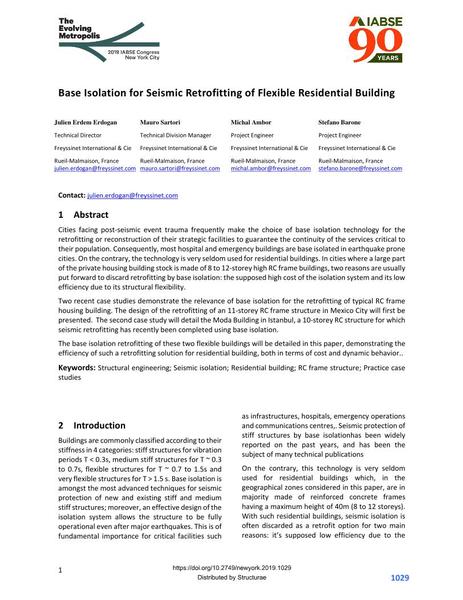Base Isolation for Seismic Retrofitting of Flexible Residential Building

|
|
|||||||||||
Détails bibliographiques
| Auteur(s): |
Julien Erdem Erdogan
(Freyssinet International & Cie)
Mauro Sartori (Freyssinet International & Cie) Michal Ambor (Freyssinet International & Cie) Stefano Barone (Freyssinet International & Cie) |
||||
|---|---|---|---|---|---|
| Médium: | papier de conférence | ||||
| Langue(s): | anglais | ||||
| Conférence: | IABSE Congress: The Evolving Metropolis, New York, NY, USA, 4-6 September 2019 | ||||
| Publié dans: | The Evolving Metropolis | ||||
|
|||||
| Page(s): | 1029-1034 | ||||
| Nombre total de pages (du PDF): | 6 | ||||
| DOI: | 10.2749/newyork.2019.1029 | ||||
| Abstrait: |
Cities facing post-seismic event trauma frequently make the choice of base isolation technology for the retrofitting or reconstruction of their strategic facilities to guarantee the continuity of the services critical to their population. Consequently, most hospital and emergency buildings are base isolated in earthquake prone cities. On the contrary, the technology is very seldom used for residential buildings. In cities where a large part of the private housing building stock is made of 8 to 12-storey high RC frame buildings, two reasons are usually put forward to discard retrofitting by base isolation: the supposed high cost of the isolation system and its low efficiency due to its structural flexibility. Two recent case studies demonstrate the relevance of base isolation for the retrofitting of typical RC frame housing building. The design of the retrofitting of an 11-storey RC frame structure in Mexico City will first be presented. The second case study will detail the Moda Building in Istanbul, a 10-storey RC structure for which seismic retrofitting has recently been completed using base isolation. The base isolation retrofitting of these two flexible buildings will be detailed in this paper, demonstrating the efficiency of such a retrofitting solution for residential building, both in terms of cost and dynamic behavior.. |
||||
